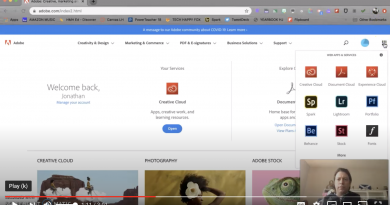Spokesman Staff Revamps Production Schedule to Meet New Needs
Organizing your staff and your production schedule to be a news organization with multiple ways to publish
The latest dilemma for advisers and editors is how to get their staffs to create content for the web. How do we create enough content for both print and web? How do we create content for the web without the print publication suffering? How do we create enough content for both publications without burning out our staff?
Last spring, the Spokesman staff at Wheeling High School decided to take on this challenge. As the adviser, I decided first off that we needed to think differently about what we were trying to do. We needed to go back to basics. So we started by brainstorming about our purpose as high school journalists and our real goals as a news publication. We also attended lots of sessions at local and national journalism conferences and conventions. Here’s what we came up with.
Our website should not just regurgitate what we print on paper
One of the editors in chief last year attended a session that pointed out the readerships of print and web are not necessarily different, what the readers expect to find in the two places is different. Readers go to the web for information that they need to know NOW. They expect the latest updates to be online. They also want the interactive pieces online. They like to find photo galleries and videos (done well) on the website. Readers go to print for in-depth stories, the analysis. They still like the photos, but they like the powerful-all-it-takes-is-one-image photo story in the print edition. This led us to the decision that we needed to cater our content for each publication to what readers look for in that publication.
We are not “web journalists” or “print journalists,” we are JOURNALISTS
We made the decision that we are journalists first, our stories come first. The publication platform should fit the story, not vice versa.
The result
These decisions led us to a need to reorganize our production flow calendar. The three weeks to write two stories and one week to produce the publication wasn’t conducive to our new philosophy. It put too much emphasis on print.
I attended a session last spring at the national convention where I heard Tom Gayda, director of publications at North Central High School, and his students speak about converging the newspaper, yearbook and online staffs. It was in this session that I learned about the one week production schedule. We adopted that idea and then recrafted it to fit our needs.
Create the content, then decide where it will go
Our content production week starts and ends on Wednesdays. Stories, photos and infographics are assigned on Wednesday. Every staffer gets assigned either one story, two photo shoots, or two infographics. They have one week to complete their assignments. The next Wednesday night, after the assignments are turned in, the editors edit. On Thursday morning, the editors have a meeting where they discuss the stories, photos, and infographics to decide the best platform for publication for each. From there, the web editor creates the web publication schedule and the associate editor updates the budget for print.
Using Maestro to balance emphasis
Our new schedule is taking some getting used to, and it is not perfect. It moves much more quickly than the old schedule. Time for procrastination is gone. However, we also realized that the time we used to spend planning our coverage and pages has evaporated in the rush to complete our weekly content. We were emphasizing web more than print. So, we are adjusting again. We are making a slight move back to the four week production schedule. We still have weekly content assignments. But for the second two weeks of the month, we are using a Maestro model.
The maestro teams, one for each content section and one for web (which is focused on multimedia content now), meet on the third Wednesday. They inventory the content created in the previous two weeks. They decide what content needs to be created in the next two. The maestro products will be the pages of the print edition and the web updates for the next week and a half. The web maestro team now focuses on web updates and multimedia. The section teams plan the print pages. These maestro teams work for two weeks on their projects. However, they are still creating content each week. Now that content is focused on the maestro product. Finishing the maestro product takes us back to week one and a focus on finding stories to tell.
It’s messy.
We have found that the new system definitely puts the focus on covering stories, not just filling a publication. However, we still have trouble updating our website every day and having the best stories to print. We realize this problem stems more from our deadline troubles, not the ideas or content itself. We’ll keep working though. With a clear philosophy in mind, we are on the road to sanity and great content directed to our readers.
Our calendar
| Week | Monday | Tuesday | Wednesday | Thursday | Friday |
| 1 | • Web story posted | • Print Final Deadline Night • Web story posted |
• Content Assigned • Web story posted |
• Blogs updated | • Print Distribution • Online Poll Updated • Multimedia posted |
| 2 | • Web story posted | • Web story posted | • Content Deadline • Content Assigned • Web story posted |
• Blogs updated | • Online poll updated • Multimedia posted |
| 3 | • Web story posted | • Web story posted | • Content Deadline • Maestro Meeting 1 • Webs story posted |
• Blogs updated | • Online poll updated • Multimedia posted |
| 4 | • Web story posted | • Maestro meeting 2 – Page Layout • Web story posted |
• Web story posted | • Blogs updated | • Online poll updated • Multimedia posted |
| 1 | • Web story posted | •Print Final Deadline Night • Web story posted |
• Content Assigned • Web story posted |
• Blogs updated | • Print Distribution • Online poll updated • Multimedia posted |




This great!
What a great article Karen. So many staffs, print and electronic, can learn from this approach.
Mrs. Barret – I didn’t realize you did this! Great job! 🙂
I’m so proud to be apart of this staff!
Pingback:Newspaper online reporting 3 « Room 118
Pingback:Journalism 4/22 « Room 118